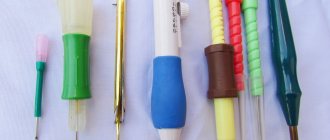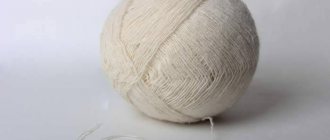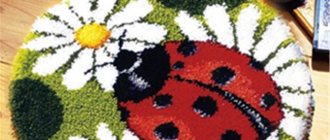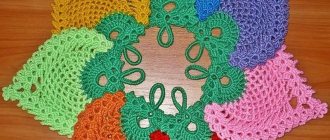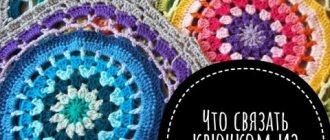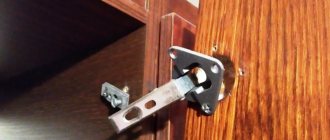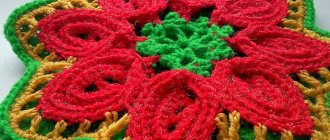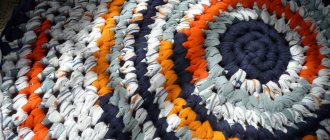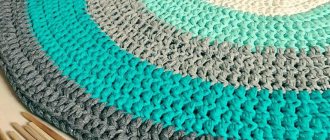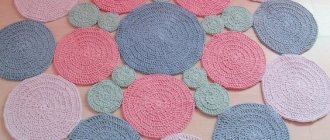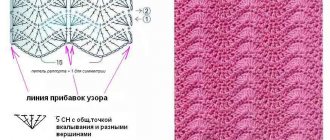A loop of thread, created by hand, often acts as a partner for a button on fasteners or a hook. However, before creating a part, you will need to first determine its future location on the product, taking into account that fasteners with such loops can be used in those areas of finished items where they will not experience high loads, otherwise they may break.
The thread part does not need to be displayed, so it should be located inside the product. To obtain a less noticeable loop, it is recommended to use threads that match the tone of the base material.
How to make an air loop from threads
Sometimes craftswomen, especially when working with thin fabric, need a neat loop for fastening. This applies to those styles where the edges of the product are connected end-to-end. This element is also suitable for connecting parts in lace and knitted clothes. An air loop made of threads will best cope with this role. It can be done with two tools: a sewing needle or a craft hook.
Reference! You should not equip this part in places of strong tension, since this variation cannot withstand heavy loads.
How to make an air loop with a needle
The best way to complete this detail is to use matching thread and a sewing needle.
Most often, this element is used as a pair to a hook or button. Its dimensions should not greatly exceed the diameter of the fastener . For example, for a button this indicator should be larger by just a couple of millimeters .
There are two main options for the needle method:
The first step is to mark the location of the fastener. To do this, use tailor's chalk or a small soap.
The simplest method is to intertwine two bundles of threads together in a spiral and then sew them to the fabric.
Now let’s look at the execution of the remaining types in detail.
How to make a simple loop
When using a simple version, you get a chain that imitates crochet .
- To begin, fix the tip of the thread (in several folds) to the fabric with several transverse stitches.
- Then we make another stitch, but we do not pull the fiber completely through the material. A small loop forms on the surface.
- We pull the thread going to the needle through the left area.
- Repeat this action a sufficient number of times until a “pigtail” of the required length is formed.
- We stretch a needle and thread into the last loop for fixation and sew the resulting element to the fabric at the second mark.
How to make a twist clasp
The second method uses a technique similar to tatting and macrame. Fix the thread in the same way as for the first variation, and then perform the following steps.
- Make several stitches between the marks so that a tight arc of the desired size is formed.
- Then wrap the workpiece using the method shown in the diagram.
- Having formed an arc of the required size, fasten the thread from the wrong side.
Attention! Make the turns quite tightly, but do not overdo it.
Secrets of weaving
There are several methods for creating loops. The work can be done with a simple sewing needle or crochet hook. These two methods are radically different from each other, although as a result both look just great.
Loops made with a needle look incredibly neat, and you can’t always tell that it’s handmade. First you need to select a place for the loop and fasten the thread at a certain distance from the edge (1-1.5 mm). The next step will be a set of arcs, their length depends on what you will need to hook the loop to, and the number depends on the desire and type of product. A standard curtain loop is 3-5 threads. The main thread should not be laid in one direction, but the direction of the needle should be changed, first from left to right, then back, each time pulling a new arc and adjusting the length of the turn.
In order for the loop to look neat and be as secure as possible, it should be overcast. To do this, use a tatting stitch (a loop stitch, but with alternating knots - first the needle enters the loop of the overcasting knot from the front, then from the back), a Gedebo stitch and a double loop.
The stitching is completed by piercing the fabric with a needle and securing the thread at a short distance from the loop. So its edges seem to be smoothed and strengthened. These methods are best suited for thin materials, and if you are faced with the question of how to make a loop of thread for a button, an air fastener made with a needle is the most correct solution.
How to make a chain loop with crochet
There are also two options for making a hook fastener.
- Air chain;
- Single crochets.
The initial stage looks the same as when working with a needle.
For the first method, after fixing, you need to perform a chain in. item of the required size and fasten it to the fabric.
The second option involves additional tying of the chain next to the RLS. This method is especially suitable for making fasteners on knitted fabric.
This variation is the strongest of all the elements presented. This part can also be made separately and sewn on with a needle.
What to do?
Don't let the lack of an overlocker bother you. You can sew the overlock stitch by hand. It's not as difficult as it might seem at first glance. Of course, you will have to spend much more time, but the result may look very decent in appearance.
What is an overcast stitch? We use it for finishing fabrics during the sewing process. At the same time, they can be used to fasten individual panels. Thanks to this, you can get a very neat tissue cut. There are several ways to make an overcast seam by hand. And in our article we will try to touch on some of the subtleties of this work.
The photo below demonstrates quite clearly what a hand-made overcast seam looks like in a product.
How to make loops from threads?
Hello again!
Thread loops are used as a partner for a hook or button on fasteners.
But before making a thread loop, you need to decide on its future location on the product. And remember at the same time that fasteners with thread loops can only be used in those places on finished products where they will not be subject to very heavy loads. They simply cannot withstand significant pressure on their “shoulders” and will burst.
The thread loop is never put on display. It is always located somewhere inside, away from prying eyes. To make it as less noticeable as possible on the product, it is made with threads in the color of the base material.
Having decided on its future location on the product, you also need to decide for yourself whether this loop will “work in tandem” with a hook or a button. Because a flat loop will be enough for a hook, but for a button the thread loop should rise somewhat above the surface of the material. The volume of space between the loop and the surface of the material should match the size of the button and be even a little larger. The button should fit freely through the buttonhole.
So, first we sew on a hook or button and use them to determine where the loop will be, what type it will be and what size it will be. It would be best to make marks on the fabric to indicate the edges of the future loop.
According to the method of execution, thread loops are of two types - chain and overcast with overlock stitches.
Chain loop or air chain.
In the place where the beginning of the thread loop will be located, we make a small stitch (without piercing the front side of the product).
We leave a small tip of the thread (while it is in “free flight”).
With a couple of stitches we secure the thread (one end of the loop) in this place. We lay the stitches one on top of the other.
We make one more stitch, but this time in order to form a loop from it.
Button loop direction
Having calculated the size of a button loop, you need to determine its direction: the loops can be directed horizontally or vertically.
Vertical hinges
Vertical buttonholes are more suitable for thin and delicate fabrics. The tension from the button is distributed evenly throughout the entire loop. The button is located in the center of the buttonhole. On shirts with a button placket, vertical loops are usually made in the direction of the grain.
Male or female clasp?
If you want to follow the tradition that the fasteners of men's and women's clothing point in different directions (we won't go into the history here), know that on a women's shirt the buttonholes are made on the right side, and the buttons are sewn to the left side (from the point view of the person wearing it). On a men's shirt it's the other way around: the buttons are on the right side, the loops are on the left.
Horizontal loops
On thick fabrics, loops are most often placed horizontally, or perpendicular to the edge of the fabric. Such loops are made on coats and jackets. Horizontal loops give more freedom than vertical ones, so they are preferable for the waistband of trousers or skirts. The button tends to sit at the end of the loop, creating tension.
How to make air loops from threads
An air loop can perform not only a functional, but also a decorative function on a blouse or dress, and it can also be made from threads.
As a rule, air loops are made from the fabric of the product, but you can also use a corset or round cord or roller. In addition, it is possible to make air loops from threads. The main thing to keep in mind is that fasteners with thread loops can only be used in cases where they will not be subject to heavy load. In terms of strength, they are certainly inferior to traditional options, which means they can rupture under significant pressure.
You will need:
Fasten the thread on the wrong side and bring the needle to the front side at the point where the loop begins. Place a loop over your finger (the loop should be large enough for the button to fit through), and then insert the needle at the second point of the loop to the wrong side and out onto the face at the first point.
Repeat the last step 3-4 times to make the loop thicker. Holding the project in your left hand, place the thread on your index finger and pass the needle through the loop, as in the photo.
Pass the needle through the second loop on your index finger, then remove your finger and tighten the thread, pushing the resulting “knot” to the base of the loop.
Repeat the previous step, continuing to add more and more stitches until you make sure they fit together fairly tightly.
When you reach the end, securely fasten the thread from the inside out.
Button loop location
If the garment is symmetrical, horizontal or vertical loops are placed in the front center. When choosing the location of the loops, consider the direction of the grain thread - this way they will be stronger.
Test buttonhole
To make sure that the size of the buttonhole corresponds to the size of the button, first make a test buttonhole on a piece of fabric, observing the same conditions: threads, number of layers of fabric, interlining material, etc. Try threading the button through a test loop to check the correct size.
To position the loops correctly, take into account their length (for vertical loops) or their width (for horizontal loops). Place the loops on the same line and maintain the same distance between them.
Marking the placement of vertical loops on a cambric button placket
General layout of loops
Methods for hanging curtains: thread loops
Curtains are hung using a variety of methods, and usually the priority is not the method itself, but the design, that is, how good it looks in the end. Therefore, in such a matter, the main thing is rational application. In general, the following curtain mounts are most often chosen.
These are metal rings that compress the material on both sides, and there is nothing in the middle for stringing onto a pipe.
They are purchased and sewn onto non-stretchy ribbons or rings of the same material; they can be metal or plastic.
The edges of the curtains are grabbed and secured at the same distance.
Required tools and materials
To make this fastening method, you don’t even need a sewing raspberry - it’s enough to have basic sewing skills.
To make loops, in addition to the selected yarn, you will definitely need a crochet hook, already prepared material and scissors. You will need a lot of yarn, and the hook is selected depending on the thickness of the thread.
The thicker the thread, the larger the hook is needed, at the same time, if the thread is thin, you should not use a thick hook - it will be inconvenient to work with, and the finished loops will look unaesthetic and stretched.
Advantages of thread loops
If you have basic sewing skills, yarn loops are a quick, easy way to hang curtains, drapes, or regular tulle.
It is only necessary to calculate the load and density of the materials.
- Practicality. Some variations of thread fastening involve simple replacement or restoration of the element.
- Safety. If the yarn is selected correctly for the main fabric, then the likelihood of breakage is very low. Even if there are small children and animals in the house.
- Aesthetics. It always looks stylish and beautiful, especially if the fabric fastening has a “character” that consists in emphasizing either addition or secrecy.
- Versatility. If after the move it turns out that the cornices have a different structure, or the original ones do not fulfill their function, then this variation of fasteners can still help out the owners.
Also a big plus is the simplicity of the method - you can do it with your hands and a couple of sewing tools and get very elegant results.
Conclusion
Curtains made of any material need fastening that will favorably emphasize the advantages of the fabric and highlight features: sophistication, sophistication or playfulness, as well as rigor and restraint.
As a result, you will receive reliable fasteners for curtains that will last a long time and will not spoil their appearance.
Self-made curtain loops can contribute to this in the best possible way, since the craftswoman herself chooses what to emphasize and what not to highlight. Only for this it is necessary to calculate all the nuances, plan correctly and implement it into reality without defects and errors, so that the result brings pleasure for as long as possible.
How to make loops on curtains from threads and more
This enterprise is manual labor, so to create loops you will need: a needle, in some cases a hook, thread, scissors, a ruler (or centimeter), basic material and step-by-step instructions. Basic skills are also important, you need to be able to: make a knot, know common types of seams, be able to perform and make markings with special chalk (remnant).
For classic white tulle, it is better to choose a white thread.
Method of making threads with a needle
There is more than one way to make loops from threads with a needle. Each of them deserves attention, since usually the process of creation involves careful selection and production of even those elements that will not be visible.
If the fabric is multi-colored, iridescent, or has a pattern of a specific color on it, you should choose it based on how the finished product will look most natural.
Standard method - air loop
- Mark the beginning and end of the work with chalk.
- Determine the length of the chain.
- At the very beginning of the mark, you need to make a horizontal stitch, leaving a “tail of thread” of a couple of centimeters. Now make a few more stitches.
We determine the locations of future loops by dividing the distance into the required number of equal intervals.
We sew twice without tightening the loop.
We pick up the thread from the needle with our fingers through the loose thread.
Pass it through the thread and tighten it to form a loop of thread.
So we weave a rope of the required length (about 1 centimeter).
Insert the needle into the loop and tighten the thread.
All that remains is to sew on the second edge of the resulting loop and tie a knot.
If you get the hang of how to make loops for curtains from threads, you can make one such element in two minutes. The overall result of the work will be limited to half an hour of sewing.
The second method is an overcast loop
Part of the circuit is similar to a standard air loop, but there are nuances. After securing the first thread at the beginning of the mark, measure the required length and secure it on the second side. These two points will become the guidelines for creating shapes 0 or 8 using yarn. It doesn’t matter which one you choose, the result after the next stage will be the same.
The same loops can be made on things with small buttons.
After forming the loop in several layers, you need to wrap it along its entire length with special overcasting loop stitches. It is usually used to process a cut of material so that it retains its appearance for a long time and does not fray. This requires a needle and thread and a little patience.
First you need to position the marking horizontally in relation to yourself, then pass the needle under the layers of thread from top to bottom, forming a loop. Then it is necessary that the tip enters the loop, and a beautiful knot is tightened. And so you need to repeat until the end of the length, after which you should secure the thread with a couple of stitches and “remove” the tail inside.
How to create loops on tulle from threads
If for curtains and drapes you usually need to use strong threads or medium thickness, but in several layers, then you don’t need much for tulle. There are some nuances here, and they lie in the need to do the work especially beautifully, because everything will be visible on thin material.
It should be remembered that very thin threads still run the risk of breaking under the constant load of the fabric.
On each element you need to take care of the next one.
- Compliance with the load. Each curtain has its own weight and area, this must be taken into account when calculating and selecting yarn (a curtain fabric of 1 meter is much heavier than a curtain of the same size, and tulle of one meter is lighter, but not always by much, depending on the composition of the material).
- Symmetry. We are talking not only about the equidistance of each part, but also about the size, which assumes the same height of the lower edge in relation to the floor.
- Aesthetics. Everything should look beautiful and elegant, so the loops should be made with equally tightened knots and their sizes, neatly hidden thread tails, etc.
Having chosen the fastening option and the material for making the loops, you can begin making this method of attaching the curtain to the cornice.
Typically, the technique for creating such things does not differ from the instructions described above, where the links in the column were created. For tulle, it is necessary to select more elegant threads, and therefore it will be difficult to work with them with just your hands. But the hook method of tightening air knots will come in handy. It’s just that now it’s not the middle finger of the left hand that tightens it, but the crochet hook.
The threads should be further strengthened.
General recommendations
The process of creating curtain or tulle fastenings in itself is not difficult to perform; you just need to gain some skill. But there are also nuances that come only with experience - calculation. This is determining the length of the curtain, the distance of the bottom cut from the floor, the need to process the edges and methods, sequence. It should be taken into account that if there is an additional folded seam at the top, the length of the product will be shortened and may look untidy with too much margin.
If you want more folds and then make a beautiful drapery, then the distance between the loops can be slightly increased.
A more even canvas on the window opening is made by sewing a large number of identical loops. It is difficult to give specific numbers; one must still take into account the total length of the material, its heaviness and tendency to form folds.
Sometimes, if the fabric is thin but difficult to drape, you can increase the distance to 20 cm to “force” it to take the desired shape.
If we talk about the length of the loops themselves, how to choose them, then here it is worth starting from: the length of the material and the highest point of grip of the loops. In other words, the length should be selected individually, taking into account whether there are restrictions on distance from the floor; if you need to raise it, then the loops are shorter, but in order for the curtains to be visually longer, the loops will be calculated differently.
If the loops are not intended for decoration, then they try to place them in inconspicuous places.
Important: the distance by which the fabric needs to be raised or lowered is not equal to the length that the housewife will add or shorten, so it is better to play it safe and “try on” the product for its future location before sewing.
Lesson #1. Start of knitting. Performing a chain loop and chain
Hello, dear readers of my-crochet.ru
We are starting a series of crochet lessons, from which you will learn how to knit basic elements: chain loops and chains, half crochets, single crochets, double crochets, etc.
In this article we will look at how to hold a hook, a working thread, how to knit a starting loop and a chain of air loops. Watch the video tutorial at the end of the article.
How to hold a hook.
The hook can be held in two ways: like a pencil
or like a table knife.
Use the method that seems more convenient to you. I usually hold it like a pencil, but when my fingers get tired, I change the position.
How to knit a starting stitch.
Before we start knitting and casting on loops, we need to make an initial loop, or rather a knot.
Fold the thread into a loop
we put this loop on the hook so that the working thread is on the index finger, while holding the tail of the thread with the thumb and middle finger,
hook the thread
and pull it through this loop, tighten the knot.
The hook will be inside the loop. This is how we knitted the initial loop.
How to knit air loops.
Make the initial loop (knot) as described above, hook the working thread
and pull it through the initial loop, we get the first air loop . (v.p.)
To obtain subsequent loops, perform the same steps. We hook the working thread
and pull it through the air loop.
This is how we form a chain; it is knitted to the length required to obtain the width of the product we need. When counting the number of loops, each chain stitch is counted as one loop; the loop on the hook and the starting loop (knot) are not taken into account.
A chain of chain stitches forms the basis for knitting the first row, but it does not count as a row. This is what a chain of 10 air loops looks like in the diagram.
The chain of air loops should be knitted loosely, the loops should not be tightened.
Marking
Installing furniture hinges with your own hands involves precise markings. If you make poor markings, you can get defects when opening the door. The process of marking for furniture hinges involves finding the center of the hole for them. You should retreat 7-12 cm from the edge of the facade. The number of hinges installed on the door may vary. But you need to maintain a certain distance between the canopies, equal to 50 cm. There is a certain dependence of the number of canopies on the door parameters.
| Facade weight, kg | Front length, cm | |||
| Up to 50 | 50-100 | 100-150 | 150-200 | More than 200 |
| Number of canopies | ||||
| 4-5 | 2 | |||
| 6-9 | 2 | |||
| 10-13 | 3 | |||
| 14-18 | 5 | |||
| Over 19 | 5 |
When the number of canopies is determined, the central holes are marked relative to the width of the door. Moreover, the distance from the side of the door should be 2.1-2.2 cm. It should also be taken into account that the fastening should not lie on the location of the shelves.
Thus, having measured the required distance from the top and bottom of the door, a mark is made. Next, keeping the indentation relative to the width, the point of the future location is also marked. At the intersection of the measured marks, a notch should be made using a self-tapping screw or nail. If the facade height is more than 100 cm, marks must be made every 50 cm.
